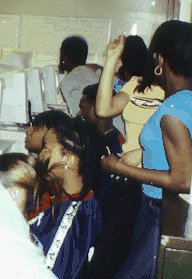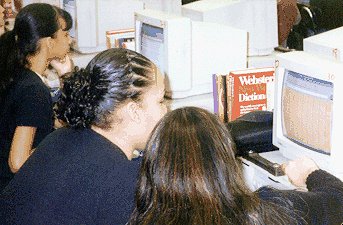|
We learn in authentic situations
- John Dewey  roviding a setting for every learner to learn in as authentic a way as possible is difficult in a class of 30 students per teacher. The difference from teacher to teacher, from student to student compounds the difficulty in trying to create anything as authentic. We are a DIVERSE people and we are all individuals. It is ironic indeed to be so diverse and yet be so driven in education by standards. In addition an interesting paradox arises when we survey our current classroom practice of teacher-centric classrooms and the theory of student-centered classooms. We will speak to our wrestling with these paradoxes and provide some practical advice and applications we use to play out the theory. We will explore the word "authentic" from a 'practical theorist' point of view as it is used in 'authentic learning,' authentic environment,' and 'authentic assessment'. roviding a setting for every learner to learn in as authentic a way as possible is difficult in a class of 30 students per teacher. The difference from teacher to teacher, from student to student compounds the difficulty in trying to create anything as authentic. We are a DIVERSE people and we are all individuals. It is ironic indeed to be so diverse and yet be so driven in education by standards. In addition an interesting paradox arises when we survey our current classroom practice of teacher-centric classrooms and the theory of student-centered classooms. We will speak to our wrestling with these paradoxes and provide some practical advice and applications we use to play out the theory. We will explore the word "authentic" from a 'practical theorist' point of view as it is used in 'authentic learning,' authentic environment,' and 'authentic assessment'.
In our attempts to try to create a more authentic learning COMMUNITY, we will find a growth in learning by the learners and ultimately their finding their own authorship and authority, and eventually real POWER. This power will come from their new found attitude towards learning. In the authentic environment, the students see the value of learning. So they become proactive in their learning. Creating an Authentic Learning Environment. Constructivist theory has driven pedagogical thinking in how to use computer classes. Computer based classes can be more project based and constructivist in design since students construct projects for webfolios. The technology helps facilitate the constructivist ideas.
Webfolios: The foundation to authenticating learning is the webfolio. A webbed based version of the portfolio, the webfolio provides the student writer with the power to publish hir words and to have control over much of the presentation. The webfolio provides the outside viewing public access. Now we have interactivity between the learner and the "learned", the mentee and the mentor, and among the peers. The webfolio is an ongoing piece of work ever evolving with the learner and it also provides archival capabilities for seeing growth and progress. Because it is on the web, the webfolio brings life to the learner's learning, engages hir more in the process of learning, and links hir to hir community. The webfolio allows for constructivist theory to be practiced. As teachers we come from the notion that learning was delivered from the teacher. Most media prior to the Internet was one way. Television, radio, lecture are all one way transmissions. Learner receives but does not send. The Internet changed that and introduced a truly interactive environment. Not only are the students harvesting from the net, they are planting, planting their thoughts and ideas via the webfolio. This is authentic because the world can now actually see what is going on in the schools and not hear from the media or politicians. The netizens can make up their own minds, they can interact. Interaction promotes understanding and learning. By making the students' work public, we believe a more authentic learning can happen. This is our way of practicing our theory as Elbow iterates on the matter of portfolios. Authentic Learning:
Before teachers can take a class into a cyber room, perhaps it would be wise for the teacher to explore what other teachers have done. Surf the web, search out through the many web based resources to find teachers who have created their own web pages for their students to use either in or not in a cyber room. Many teachers still teaching in non-computer rooms use the web to post assignments and to provide links to resources for their students. Additionally, many use email to correspond with their students. As each teacher begins the morphing process and becomes more familiar with the web, of its strengths and weaknesses, that teacher will begin to see the possibilities of how to cobble a cyber class of hir own. An epiphany is the first step to creating one's own cyber room. This is the sound pedagogical theory that Robert Fried, in The Passionate Teacher, suggests we practice. Fried's practical theory reminds us of Robert Frost's PERSONAL choice dilemma in "The Road Not Taken." Being a practical theorist is messy and it will take time and a willingness to fail and to experiment. But through it all, we believe, the teacher who struggles with the cyber room and hir own pedagogy will eventually arrive at the same conclusions we have: the cyber room provides a good platform for us to practice our theory effectively, to the benefit of the students in our classes. Authentic Assessment: According to Fried, any good grading system should:
2. Act as an incentive for students to learn new things and to keep trying even if they don't perform well at first; 3. Be simple in design and easily understood by students, their parents, academic advisors, and other teachers; 4. Support the view that assessment is part of learning, not the end of learning.
2. Are both incentives and threats, and can lower as well as raise students' confidence in themselves as learners; it can be hard for a student to recover after a bad start; 3. Are complicated, full of intricacies that can lead to endless hassles between students and teachers, easy for teachers to defend but difficult for others to comprehend; 4. Encourage students to pursue grades rather than knowledge and understanding.
Authentic Assessment is the subject of Ted's teacher research at the Carnegie Foundation, which supports Teacher Research. Teacher research provides teachers with the opportunity to explore their own pedagogy and to better practice that pedagogy in the classroom. Teacher research also serves as a model to show the teacher's students how to become scholars themselves. Think about yourself as a learner. What situations do you learn best in? Most people would have to admit that it was one in which they had a vested interest-- learning to sail, to use a computer, to drive, to play an instrument. School is not an authentic setting; most of our students are there because they have to be. The best we can do is offer them as close as we can to an authentic situation by giving them some choice, some freedom to explore and discover, and some sense that what they're doing matters. How does one begin? First, we suggest that the teacher begin to use the Internet to do hir own work and to find ways of transferring current delivery system of books and handouts to webpages students access. Secondly, have students create their own webfolios on any of the free web spaces and begin publishing their work on line. Thirdly, have the students engage in peer review. Fourthly, use email to communicate with your class. And finally, use all of your pedagogy to mold this new cyber room into your own version of your practical theory. Oh and keep a journal of your journey to share with others.
© TedNellen & Lori Mayo 2000 |


